The United States Fingerprint Identification Module for Door Lock Market is projected to grow significantly, driven by ongoing advancements in biometric technology and rising security concerns. Expected to reach USD xx.x billion by 2023, the market is anticipated to grow at a CAGR of xx.x percent until 2031, with its applications spanning residential, commercial, healthcare, and educational sectors. Fingerprint modules provide enhanced security by using biometric data and are particularly attractive for their ease of use and seamless integration with existing security systems.
The United States Fingerprint Identification Module for Door Lock Market is on an upward trajectory, expected to reach a valuation of USD xx.x billion by 2023, with a compound annual growth rate (CAGR) projected at xx.x percent from 2024 to 2031, reaching USD xx.x billion by the end of this period. Key drivers of this market include advancements in biometric technologies paired with heightened security concerns among consumers. These fingerprint identification modules provide a secure and convenient entry solution for both residential and commercial properties, replacing traditional key systems with biometric authentication based on unique fingerprint data. In residential settings, fingerprint modules gain popularity as they offer homeowners a reliable and accessible security option, eliminating the need for physical keys. On the commercial side, there is an increasing demand for these modules within corporate offices, hotels, hospitals, and educational facilities where enhanced security measures are essential. These systems facilitate efficient access control, allowing only authorized personnel entry into sensitive areas, and can easily integrate with existing security infrastructures, making them attractive for businesses looking to modernize their access systems. The healthcare sector has also begun adopting fingerprint technology to safeguard patient information and medical supplies, thus adhering to stringent regulatory standards while improving operational efficiencies. In educational institutions, these systems secure access to campuses and facilities, ensuring that only authorized individuals have entry to critical areas, which in turn promotes a safer learning environment. As biometric technology continues to evolve, the fingerprint identification module market is expected to benefit from improved accuracy and reliability, leading to higher adoption rates across various sectors. This trend signifies the critical role that efficient and secure access control systems will play in the United States across residential, commercial, healthcare, and educational applications.
The fingerprint identification module for door locks serves as a modern alternative to traditional access methods such as keys or passcodes. In an era marked by increasing security threats and rapid technological advancement, these systems leverage biometric recognition to provide a seamless entry experience while enhancing overall security. With issues like unauthorized access and the need for effective access management becoming more central to operational strategies across various sectors, the growth trajectory of this market reflects broader trends in smart home technology and safety requirements. The segmental application across residential, commercial, healthcare, and educational spheres illustrates diverse use cases and the universal demand for reliable security solutions.
The United States Fingerprint Identification Module for Door Lock Market is poised for substantial growth, driven by technological advancements and the growing importance of security. By providing a convenient, secure, and efficient access method, fingerprint identification modules are becoming increasingly essential across various applications, from homes to corporate and educational environments. As the market adapts to technological enhancements, the demand for these biometric solutions is expected to increase, highlighting their critical role in future access control strategies. The overall outlook remains positive, bolstered by rising concerns over security and an ongoing commitment to leveraging cutting-edge technology for enhanced safety.
Original Source: thirdeyenews.in







